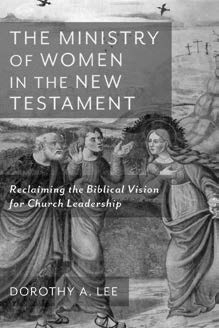The Ministry Of Women In The New Testament: Reclaiming The Biblical Vision For Church Leadership -- By: John Kitchen
Journal: Eikon
Volume: EIKON 03:2 (Fall 2021)
Article: The Ministry Of Women In The New Testament: Reclaiming The Biblical Vision For Church Leadership
Author: John Kitchen
Eikon 3.2 (Fall 2021) p. 111
The Ministry Of Women In The New Testament: Reclaiming The Biblical Vision For Church Leadership
REVIEWED BY
John Kitchen (D.Min., M.Div.) is the author of a dozen books, including Proverbs: A Mentor Commentary (Christian Focus Publications, 2006, 2012) and the “for Pastors” New Testament commentary series (Kress Biblical Resources).

Dorothy A. Lee. The Ministry of Women in the New Testament: Reclaiming the Biblical Vision for Church Leadership. Grand Rapids, MI: Baker Academic, 2021.
Introduction
The title is inviting: The Ministry of Women in the New Testament. One would welcome a comprehensive, evenhanded pursuit of what the New Testament reveals about women in service to God and others. It is the subtitle, however, that hints at the actual contents of the book: Reclaiming the Biblical Vision for Church Leadership. The true “Biblical Vision” must be reclaimed, having been hijacked by a misogynic (3, 11, 188), racist (3), abusive (11, 187, 188), idolatrous (182, 185), deceitful (“guise,” 1; “misleading,” 11), “domineering,” and “scummy” (182) theological splinter-group (“a reactionary movement,” 3; led by “Reactionary scholarship,”(122) who are misleading the faithful. The book thus touts itself as something of a “myth” buster (191), streaming the light of truth into the descending darkness of a complementarian night.
Eikon 3.2 (Fall 2021) p. 112
Summary
The book is divided into two unequal parts, a review of women’s ministry in the New Testament (15–150) and a briefer review of women’s ministry in the tradition of the church (151–184).
The seven chapters of the first section discuss each book of the New Testament except 2 Peter and Jude, with Luke and Paul each receiving two chapters.
The second, shorter section explores some of the tradition of the church, mostly in the first five hundred years after Pentecost. Chapter eight (“History and Texts”) searches post-canonical writings, arts and artifacts, and the “Early Church Mothers” for support of an egalitarian position. Chapter nine (“Theology”) makes several women equal to “the Twelve,” explores “Women and the Divine Image,” the place and role of the Virgin Mary, and the matter of “Gender and the Trinity.”
The conclusion (185–191) summarizes points already made and makes demands for their application today.
The intent is clear: “The purpose of this study is to revisit the arguments against women’s full participation in ministry and leadership within the church...
Click here to subscribe
